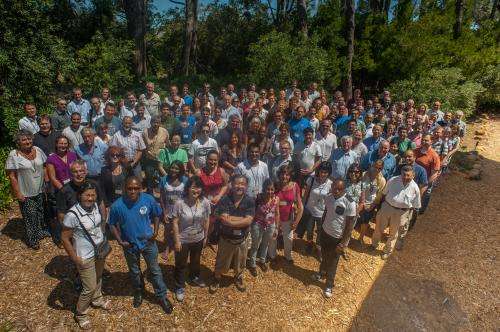The SKA will transform our understanding of the Universe

The Who's Who of global radio astronomy gathered in Stellenbosch this week to discuss future science with the SKA. The meeting was characterised by "electrifying expectations" and "impatient excitement" on the part of scientists who are keen to see the long-awaited SKA (Square Kilometre Array), and its precursors such as South Africa's MeerKAT and Australia's ASKAP, become a reality.
The SKA Project is an international enterprise to build the largest radio telescope in the world.
The more than 160 delegates at the conference included high-level delegations from China, South Korea, the UK, Germany, Italy, Sweden, Argentina, Australia and the US. "There is a global buzz about doing cutting-edge science with the SKA and the project is already attracting some of the world's foremost scientific talent to South Africa," SKA SA project director Dr Bernie Fanaroff said.
At the opening session of the conference the Director General of the SKA Organisation Professor Philip Diamond emphasised the fact that the SKA would be a global observatory and not an experiment.
"The SKA is an amazing science discovery machine," explained astrophysicist Professor Katherine Blundell from the University of Oxford in the UK. "With the SKA we will be able to see fuller, reach deeper and understand better. It will literally expand our horizons and give us a much clearer picture of how the Universe came to be what it is today."
Like all the other scientists at the meeting this week, Professor Michael Kramer, Director of the Max Planck Institute for Radio Astronomy in Germany is thrilled about the future possibilities of the SKA. "I can't wait to get my hands on SKA data," he said.
"There will be a clear distinction in radio astronomy research between before and after the SKA. All the radio astronomy research done up to now will be a prelude compared to what will be possible in future."
When asked about why the SKA is seen as an instrument that will transform radio astronomy, scientists talk about its sheer size, exceptional sensitivity, wide frequency range and unique flexibility. It is described as a "one of a kind" instrument that has the power to unite the global radio astronomy community to work towards common science goals for several decades.
"The SKA will also achieve lots of synergies with other telescopes across all electromagnetic frequencies, ranging from optical telescopes to new, high-energy telescopes on Earth and in space, as well as with gravitational wave predictors," Professor Kramer added. "We are lucky to live in a time when all these instruments will be working together to give us new windows on the Universe."
Amongst those at the meeting is Professor Pierre Cox, Director of the ALMA radio telescope in Chile. ALMA operates at very high radio frequencies and will have important synergies with South Africa's MeerKAT telescope and the SKA.
Experts at the meeting agreed that the SKA presents wonderful opportunities for young men and women in Africa to be the engineers, computer scientists and astrophysicists that will make the technology happen and produce the transformational science outcomes that will only be possible with the SKA.
A special session at the conference focused on making the science of radio astronomy accessible to learners, including a group of children from the primary and secondary school in Carnarvon. Top scientists took on the challenge to present their research to these young people in small groups and to answer all their questions about astronomy and the Universe.
Another highlight of the week was a public talk by Dame Jocelyn Bell Burnell, famous for her role in the discovery of the first radio pulsars. She launched the audience into a world of unimaginable extremes with her talk about pulsars and fast radio bursts. "The SKA will not only enable astronomers to see ten times as many pulsars as is currently possible, but will also bring about new and unexpected discoveries," she said. "South Africa is going to be a very special place in the near future of radio."
The meeting concludes in Stellenbosch today (Friday 21 February 2014) with a summary of the week's discussions by Professor Roger Blandford from Stanford University, who convened the USA's 2010 Decadal Review of priority astronomy projects.
More information and photographs are available on www.ska.ac.za and www.skatelescope.org
Provided by SKA